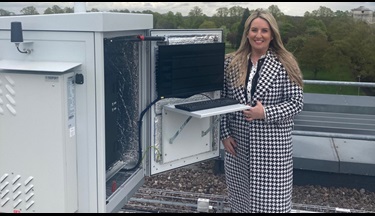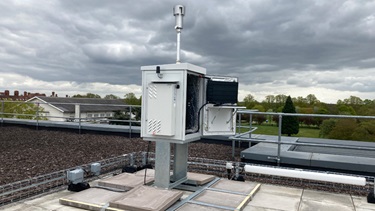Leicester and Leicestershire can breathe easy as university unveils pollen monitor
As hayfever sufferers feel the first symptoms of their seasonal condition this spring, researchers in Leicester have switched on a state-of-the-art air sampler which will allow them to monitor pollen circulating in the city’s air in real-time.
The Swisens Poleno sampler was ‘switched on’ by Anna Church (below left) from BBC East Midlands Today on 24 April 2024 and is now up-and-running 20 metres high on the roof of the University of Leicester’s George Davies Centre.
 The sampler is now providing researchers at the National Institute for Health and Care Research (NIHR) Leicester Biomedical Research Centre (BRC) with real time monitoring of pollen levels in the outdoor air. The levels will be shared with the public on social media platform X every day from mid-May.
The sampler is now providing researchers at the National Institute for Health and Care Research (NIHR) Leicester Biomedical Research Centre (BRC) with real time monitoring of pollen levels in the outdoor air. The levels will be shared with the public on social media platform X every day from mid-May.
Professor of Environmental Epidemiology at the University of Leicester, and lead of the NIHR Leicester BRC’s Environment theme, Anna Hansell, said: “Improving our ability to monitor biological particles, such as pollen, in the air will complement our current research into air pollutants, and the effects they have on human health. Prior to the Poleno, the data we had was from the previous day, at best.
“The Leicester machine is part of a growing national and international network of Swisens Poleno samplers, which will allow us to work together with other institutions around the world to observe trends and patterns of air quality, pollen types and levels. It will allow real time advice to be given to asthma and hay fever sufferers.”
Professor Sarah Davies, Pro Vice-Chancellor and Head of the College of Science and Engineering at Leicester, added: “Researching how our changing environment impacts human health is at the heart of the University’s guiding principles. I am delighted we are investing in instrumentation that will enable continued research into pollen and fungal spore exposure and their role in allergies and respiratory disease in a rapidly changing world. This translational scientific research will lead to changes in practice to improve public health.”
Hay fever is an allergic reaction that occurs when the immune system overreacts to allergens present in the air, such as pollen.
Symptoms can include sneezing and coughing, a runny or blocked nose, itchy, red or watery eyes, itchy throat, mouth, nose and ears. Besides making sufferers feel miserable, hay fever can affect how well people perform at work or school and can generally interfere with quality of life throughout the spring and summer months.
The Swisens Poleno Jupiter samples high volumes of air to detect small concentrations of pollens circulating within it. The machine then characterises each particle’s optical, geometrical and physical properties, providing researchers with detailed data within a few milliseconds.
New pathing, lighting, power, data ports and a custom support base was commissioned for the Swisens Poleno to anchor it in place safely on the roof of the University of Leicester’s George Davies Centre.
A guest at the event, and collaborator on the project, Dr Martin Stern MBE, a medical advisor at the Midlands Asthma and Allergy Research Association (MAARA), said: "Until recently we could only count pollen and spores in the air by a skilled person looking down a microscope at what had been collected in samples the day before. Sufferers might have got information on this data perhaps the day after that.
 "The new Poleno pollen counter at the University of Leicester will tell researchers how much pollen there is whilst it is still in the air! We're confident that making this real time data public will be really welcomed by people with pollen allergies, helping them to manage their condition."
"The new Poleno pollen counter at the University of Leicester will tell researchers how much pollen there is whilst it is still in the air! We're confident that making this real time data public will be really welcomed by people with pollen allergies, helping them to manage their condition."
To access results taken at the University of Leicester each day, please visit the Aerobiology team's X account.
The NIHR Leicester BRC is part of the NIHR and hosted by the University Hospitals of Leicester NHS Trust in partnership with the University of Leicester, Loughborough University and the University Hospitals of Northamptonshire NHS Group. The Leicester Real World Evidence Unit is part of the Leicester Diabetes Centre.